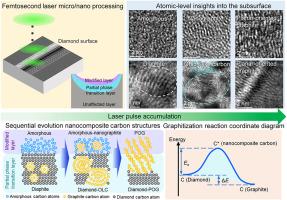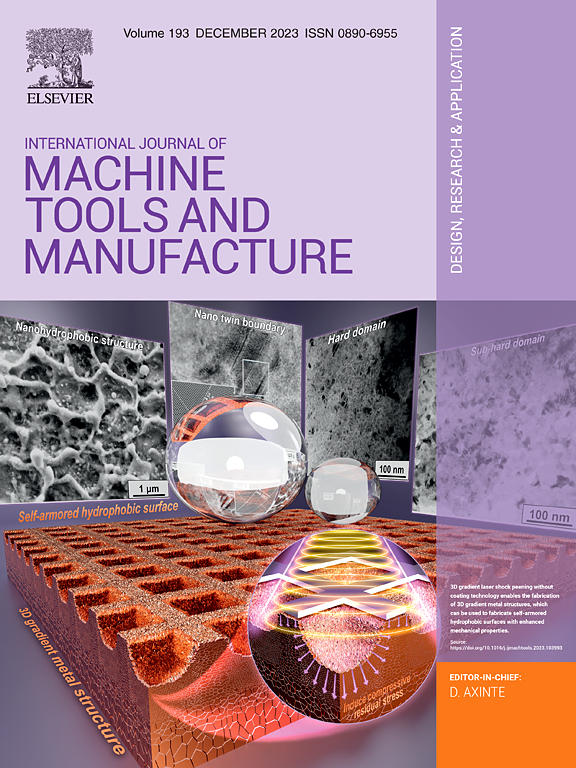Atomic-level insight into sequential evolution of nanocomposite carbon structures in femtosecond laser processing of diamond
IF 18.8
1区 工程技术
Q1 ENGINEERING, MANUFACTURING
International Journal of Machine Tools & Manufacture
Pub Date : 2025-01-18
DOI:10.1016/j.ijmachtools.2025.104247
引用次数: 0
Abstract
Diamond is an exceptional wide-bandgap semiconductor for electronics and quantum technologies. While femtosecond laser processing enables micro/nano fabrication of diamond, the dynamic atomic-level structural evolution during this process remains poorly understood, despite its critical impact on advanced applications. In this work, we investigate the multi-stage structural evolution of diamond under femtosecond laser irradiation, uncovering new scientific findings under laser-induced extreme conditions. The continuous input of pulse energy facilitates the rearrangement of local carbon atoms in the modified layer and partial phase transition layer, transitioning them from thermodynamically unstable to stable states. We introduce a sequential evolution pathway of nanocomposite carbon structures, and reinterpret the phenomenon previously broadly defined as “graphitization”. Specifically, the evolution of diaphite, diamond-OLC (onion-like carbon), and the transition from amorphous carbon to planar-oriented graphite are reported under femtosecond laser surface processing. These phase transitions are initiated by the rapid lattice heating, with their distribution influenced by near-field enhancement effects arisen from surface nanostructures. This work provides atomic-scale insights into diamond's response in femtosecond laser processing, offering a theoretical foundation for ultra-precision micro/nano fabrication of diamond and the development of functional carbon materials.

飞秒激光加工金刚石过程中纳米复合碳结构序列演化的原子水平研究
金刚石是一种特殊的宽带隙半导体,用于电子和量子技术。虽然飞秒激光加工可以实现金刚石的微/纳米制造,但在这一过程中,原子水平的动态结构演变仍然知之甚少,尽管它对高级应用有重要影响。在这项工作中,我们研究了飞秒激光照射下金刚石的多阶段结构演化,揭示了激光诱导的极端条件下新的科学发现。脉冲能量的连续输入促进了修饰层和部分相变层中局部碳原子的重排,使其从热力学不稳定状态转变为稳定状态。我们介绍了纳米复合碳结构的顺序演化途径,并重新解释了以前广泛定义为“石墨化”的现象。具体来说,报道了飞秒激光表面处理下膜片、金刚石- olc(洋葱状碳)的演变,以及从无定形碳向平面取向石墨的转变。这些相变是由快速的晶格加热引起的,它们的分布受表面纳米结构引起的近场增强效应的影响。本研究提供了飞秒激光加工中金刚石响应的原子尺度,为金刚石的超精密微纳米制造和功能碳材料的开发提供了理论基础。
本文章由计算机程序翻译,如有差异,请以英文原文为准。
求助全文
约1分钟内获得全文
求助全文
来源期刊
CiteScore
25.70
自引率
10.00%
发文量
66
审稿时长
18 days
期刊介绍:
The International Journal of Machine Tools and Manufacture is dedicated to advancing scientific comprehension of the fundamental mechanics involved in processes and machines utilized in the manufacturing of engineering components. While the primary focus is on metals, the journal also explores applications in composites, ceramics, and other structural or functional materials. The coverage includes a diverse range of topics:
- Essential mechanics of processes involving material removal, accretion, and deformation, encompassing solid, semi-solid, or particulate forms.
- Significant scientific advancements in existing or new processes and machines.
- In-depth characterization of workpiece materials (structure/surfaces) through advanced techniques (e.g., SEM, EDS, TEM, EBSD, AES, Raman spectroscopy) to unveil new phenomenological aspects governing manufacturing processes.
- Tool design, utilization, and comprehensive studies of failure mechanisms.
- Innovative concepts of machine tools, fixtures, and tool holders supported by modeling and demonstrations relevant to manufacturing processes within the journal's scope.
- Novel scientific contributions exploring interactions between the machine tool, control system, software design, and processes.
- Studies elucidating specific mechanisms governing niche processes (e.g., ultra-high precision, nano/atomic level manufacturing with either mechanical or non-mechanical "tools").
- Innovative approaches, underpinned by thorough scientific analysis, addressing emerging or breakthrough processes (e.g., bio-inspired manufacturing) and/or applications (e.g., ultra-high precision optics).

 求助内容:
求助内容: 应助结果提醒方式:
应助结果提醒方式:


